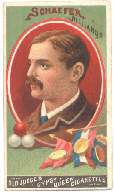Cushion caroms
 Jacob Schaefer, Sr. tobacco card, circa 1880s | |
| Presence | |
|---|---|
| Olympic | No |
| Paralympic | No |
Cushion caroms (or cushion carom billiards)[1] sometimes called by its original name, the indirect game,[2] is a carom billiards discipline generally played on a cloth-covered, 5 foot × 10 foot, pocketless table with two cue balls and a third red-colored ball. The game is sometimes incorrectly referred to as one-cushion or one-cushion billiards, which is the direct translation of its name into English from various other languages such as Spanish ("una banda") and German ("Einband").[3]
Cushion caroms is traceable to 1820s Britain and is a descendant of the doublet game dating to at least 1807, which required the sole object ball to be banked off a cushion before being pocketed or, as it was described in 1833: "...no hazard is scored unless it is made by reverberation."[3][4][5]
The name of the game is taken from the pre-existing shot. In a cushion carom shot, the cue ball caroms (strikes and rebounds[6]) off of both object balls with at least one rail being struck before the hit on the second object ball. The object of the game is to score up to an agreed upon number of cushion caroms, with one point being awarded for each successfully made. If no object ball is contacted, one point is deducted. If there is ambiguity as to whether the second ball was contacted, it is resolved in favor of the shooter.[3][7]
Cushions caroms was defunct for a number of years, but was revived in the late 1860s as an alternative to the game straight rail, in which points are scored by a simple carom off both object balls with no cushion requirement. Straight rail had for a time been falling into disfavor based on frustration by spectators with skill developments which allowed top players to monotonously score a seemingly endless series of points with the balls barely moving in a confined area of the table playing area. This was a result of the "rail nurse", a shot in which the object balls are nudged at very soft speed down a rail to a duplicate position again and again.[3][7]
Instead of stopping long runs as intended, the skills developed at straight rail were transferred over to cushion caroms. Some time between 1881 and 1889 a new nurse was developed for cushion caroms, known as the "rub nurse." With the two object balls stacked perpendicular to a rail and just next to it, the rub nurse is performed by gently banking the cue ball off the rail just before them resulting in a soft graze of both and the same or near the same position repeating.[3]

While cushion caroms waxed and waned, the game of balkline was, by the late 1870s, increasingly becoming effective at limited nursing. It eclipsed cushion caroms as the game of public match play and tournaments until well into the 20th century.[3] This is not to say that cushion caroms did not retain some popularity with the public. For example, it is known that Mark Twain enjoyed the game on occasion.[3][8][9] The presently-dominant game, three-cushion billiards, a direct outgrowth of cushion caroms also beginning in the 1870s, did not marginalize balkline until the 1920s.
The first known public exhibition at cushion caroms took place in 1867, won by Joseph Dion over John McDevitt. The first public match was won by "the wizard",[10] Jacob Schaefer, Sr., and the only world tournament at the game, in New York City in 1888, was won by Joseph Dion.
The U.S. title at cushion caroms has only been held by six men: Joseph Dion, William Sexton, Maurice Daly, George Slosson and the indomitable Willie Hoppe, who held it for 11 years from 1933 to 1944. Today, cushion caroms is rarely played in the U.S., but it still enjoys some popularity in Europe where it is featured as one of the five games making up the annual billiards pentathlons, the other four games being 47.1 balkline, straight rail, 71.2 balkline and three-cushion billiards.[3]
References
- ↑ "Saw Good Billiards: Union Leaguers Entertained by Four Star Cue-wielders". Brooklyn Daily Eagle. Brooklyn, NY: 8. December 20, 1893. Retrieved 2008-08-19. Each section of the newspaper page scans on this site can be clicked for a readable closeup.
- ↑ New York Times Company (October 28, 1888). Drawbacks to Billiards; Personal Solicitude the Source of Nearly All. Lost Professional Pride and Pluck Both Evades Public Matches and Suppresses Them. Retrieved January 2, 2007.
- 1 2 3 4 5 6 7 8 Shamos, Michael Ian (1993). The Illustrated Encyclopedia of Billiards. New York, NY: Lyons & Burford. pp. 15, 72, 82, 196 and 232–3. ISBN 1-55821-219-1.
- ↑ White and Bohn, exact date unknown (1850). The Billiard Player's Hand book. Philadelphia: Henry F. Anners. p. 38.
- ↑ Maxwell, William Hamilton (1833). The field book; or, Sports and pastimes of the British islands. London: Effingham Wilson. p. 46.
- ↑ Lexico Publishing Group, LLC (2006). Carom - Dictionary.com. Retrieved January 2, 2007.
- 1 2 Hoyle, Edmond (1907). Hoyle's Games - Autograph Edition. New York: A. L. Burt Company. p. 41.
- ↑ Paine, Albert Bigelow (1912). Mark Twain: the personal and literary life of Samuel Langhorne Clemens. New York, London: Harper & Brothers. p. 1427.
- ↑ Twain, Mark (1967). Hamlin Hill, ed. Mark Twain's Letters to His Publishers, 1867-1894. Berkeley: University of California Press. p. 168. ISBN 0-520-00560-0.
- ↑ Menke, Frank Grant (1939). Encyclopedia of Sports. New York City: F. G. Menke, Inc. p. 80.
